You are using an out of date browser. It may not display this or other websites correctly.
You should upgrade or use an alternative browser.
You should upgrade or use an alternative browser.
Rome Deity Always War
- Thread starter Zwingli
- Start date
Bam-Bam
Hammerhead
Wow. Nuff said.
Zwingli
Prince
The Turning Point

At the point where Cumea's defenses were strained to the limit, fresh reinforcements finally arrived and a critical new technology was discovered by Roman scientists which allowed a vast improvement in artillery design. The new guns shattered all attackers, allowing the 3 defensive Armies to recover their strength. Cumea was saved, and the new technology revealed a further detail of utmost strategic importance. Japan had 1 source of rubber, Zululand contained 2, but America had none. Why hadn't they traded for rubber with the Zulu? Checking via diplomatic espionage, Caesar discovered that although America had Replacable Parts, the Zulu did not.
At this moment, there was already an Army with a single cavalry escort pillaging around Washington. The same Army the Caesar had sent in his optimism on a pillaging mission years earlier now had a chance of denying Lincoln infantry forever (see the rightmost Army in this picture). Shaka couldn't be far from discovering his rubber reserves, and the pillaging team was still several turns from disconnecting Washington. Caesar nervously watched the situation at Washington each turn; if America could trade for rubber for even one season all of their cites would be instantly filled with infantry due to their huge communist treasury. The situation at Cumea had improved, but no troops could be spared to help the pillaging team in time.

At last the final link was cut, Shaka remained ignorant of rubber, and the American capital was isolated. Instantly all of America's trade deals were broken. Japan and Zululand were denied furs causing their cities to starve (they are still in Republic), while America was cut off from dyes, insence, gems, and rubber.
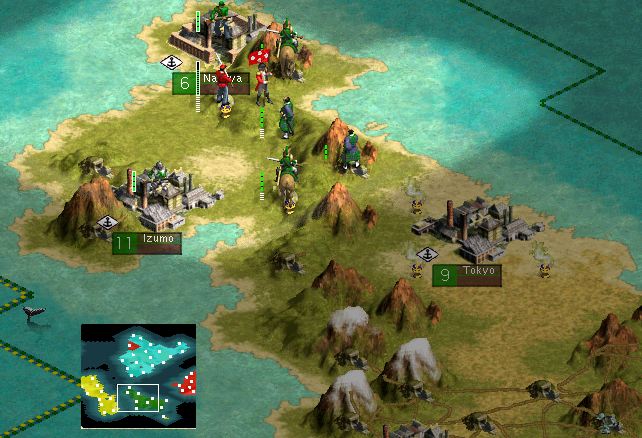
Meanwhile, the Army of Trajan with its 3 cavalry escorts had succeeded in its pillaging mission, striking a deep blow to the Japanese economy. Unlike the American island, the was no Roman city in Japan, so Tragan was attacked by Japanese forces while wrecking his damage. Combined with their loss of saltpeter, coal, and horses from American trade, Japan had been effectively knocked out of the war.
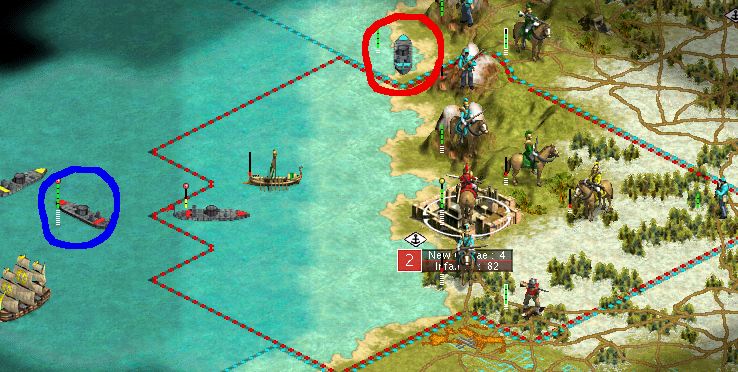
America, Zululand, and Japan still attacked Cumea with all of their strength, but with Artillery within the city walls their efforts were futile. Since factories were now in place on the Roman homeland, Caesar could afford to send serious offensive reinforcements to begin his long-delayed campaign. With a mobilized economy, America would never be able to build a hospital or compete for TOE or Hoover Dam. Lincoln did have one advantage left, his large tech lead. Beneath the marked American ironclad there is a transport, which implies the ability to build a more dangerous type of ship. Caesar did not yet understand the Corporation...

At the point where Cumea's defenses were strained to the limit, fresh reinforcements finally arrived and a critical new technology was discovered by Roman scientists which allowed a vast improvement in artillery design. The new guns shattered all attackers, allowing the 3 defensive Armies to recover their strength. Cumea was saved, and the new technology revealed a further detail of utmost strategic importance. Japan had 1 source of rubber, Zululand contained 2, but America had none. Why hadn't they traded for rubber with the Zulu? Checking via diplomatic espionage, Caesar discovered that although America had Replacable Parts, the Zulu did not.
At this moment, there was already an Army with a single cavalry escort pillaging around Washington. The same Army the Caesar had sent in his optimism on a pillaging mission years earlier now had a chance of denying Lincoln infantry forever (see the rightmost Army in this picture). Shaka couldn't be far from discovering his rubber reserves, and the pillaging team was still several turns from disconnecting Washington. Caesar nervously watched the situation at Washington each turn; if America could trade for rubber for even one season all of their cites would be instantly filled with infantry due to their huge communist treasury. The situation at Cumea had improved, but no troops could be spared to help the pillaging team in time.

At last the final link was cut, Shaka remained ignorant of rubber, and the American capital was isolated. Instantly all of America's trade deals were broken. Japan and Zululand were denied furs causing their cities to starve (they are still in Republic), while America was cut off from dyes, insence, gems, and rubber.

Meanwhile, the Army of Trajan with its 3 cavalry escorts had succeeded in its pillaging mission, striking a deep blow to the Japanese economy. Unlike the American island, the was no Roman city in Japan, so Tragan was attacked by Japanese forces while wrecking his damage. Combined with their loss of saltpeter, coal, and horses from American trade, Japan had been effectively knocked out of the war.

America, Zululand, and Japan still attacked Cumea with all of their strength, but with Artillery within the city walls their efforts were futile. Since factories were now in place on the Roman homeland, Caesar could afford to send serious offensive reinforcements to begin his long-delayed campaign. With a mobilized economy, America would never be able to build a hospital or compete for TOE or Hoover Dam. Lincoln did have one advantage left, his large tech lead. Beneath the marked American ironclad there is a transport, which implies the ability to build a more dangerous type of ship. Caesar did not yet understand the Corporation...
nivi
Call me Ishmael
Can you take a pic of your tech tree?
Nad
Known Troublemaker
I see you've got the governor controlling your cities...how useful is that in this sort of game? Is it better than manual control, because I imagine witht enemy troops marching over your land and ships bombarding, your cities could otherwise go into disorder if you are unable to use the tiles you want. Is that your reasoning behind this move?
Zwingli
Prince
@Speaker
Flight should indeed help with logistics, but since this is not PTW I would be using airports rather airfields.
-------------------
@nivi
As of 1725 AD I was behind America by at least:
The Corporation
Steel
Refining
Combustion (implied by transports)
Sanitation
Scientific Method
As well as the less important technologies of:
Espionage
Communism
Printing Press
Economics
Navigation
Music Theory
I don't know if I have a save from that point to post a tech tree, but I have all required techs up to Medicine, Replacable Parts, and Industrialization.
-----------------
@Nad (Edit: Time stamp error- replying to the post below)
Yes, I did activate the governor once I had a large number of cities with enemy troops/ships marching through and altering tile arrangements. The governor automatically reworks powerful tiles once the troops pass by, while I probably would have forgotten to reset the cities too many times for individual micromanagement to be worth it
You may have noticed that there is a furs resource hooked up South of New Cumea. This allowed me to turn off the luxury slider as it was the fifth luxury adding 3 happy people to each city with a market. However, with so many American ships floating around, the harbor was actually blockaded on many occasions which would have sent most of my civ into disorder without the govn'a . It might have been possible to use the city arrow "scroll ahead" to deal with such events, but setting and resetting the citizens of all of those cities would have been very time consuming.
. It might have been possible to use the city arrow "scroll ahead" to deal with such events, but setting and resetting the citizens of all of those cities would have been very time consuming.
--------------------------
There has been a lot of industrialized warfare going on which always takes time, but I should have another update coming up soon.
Flight should indeed help with logistics, but since this is not PTW I would be using airports rather airfields.
-------------------
@nivi
As of 1725 AD I was behind America by at least:
The Corporation
Steel
Refining
Combustion (implied by transports)
Sanitation
Scientific Method
As well as the less important technologies of:
Espionage
Communism
Printing Press
Economics
Navigation
Music Theory
I don't know if I have a save from that point to post a tech tree, but I have all required techs up to Medicine, Replacable Parts, and Industrialization.
-----------------
@Nad (Edit: Time stamp error- replying to the post below)
Yes, I did activate the governor once I had a large number of cities with enemy troops/ships marching through and altering tile arrangements. The governor automatically reworks powerful tiles once the troops pass by, while I probably would have forgotten to reset the cities too many times for individual micromanagement to be worth it
You may have noticed that there is a furs resource hooked up South of New Cumea. This allowed me to turn off the luxury slider as it was the fifth luxury adding 3 happy people to each city with a market. However, with so many American ships floating around, the harbor was actually blockaded on many occasions which would have sent most of my civ into disorder without the govn'a
 . It might have been possible to use the city arrow "scroll ahead" to deal with such events, but setting and resetting the citizens of all of those cities would have been very time consuming.
. It might have been possible to use the city arrow "scroll ahead" to deal with such events, but setting and resetting the citizens of all of those cities would have been very time consuming.--------------------------
There has been a lot of industrialized warfare going on which always takes time, but I should have another update coming up soon.

Zwingli
Prince
Strategic Map of America (168k)
7 loaded galleons with their ironclad escorts brought in a large supply of fresh cavalry, infantry, and artillery at 1730 AD. As American forces continued to focus on Cumea, a sizable group of artillery was brought to bear on Atlanta, causing great damage to the rifleman defenders and allowing cavalry to charge in and destroy the city. However, casualties were high while taking Atlanta, and replacing losses would not be easy now that America had modern ships.
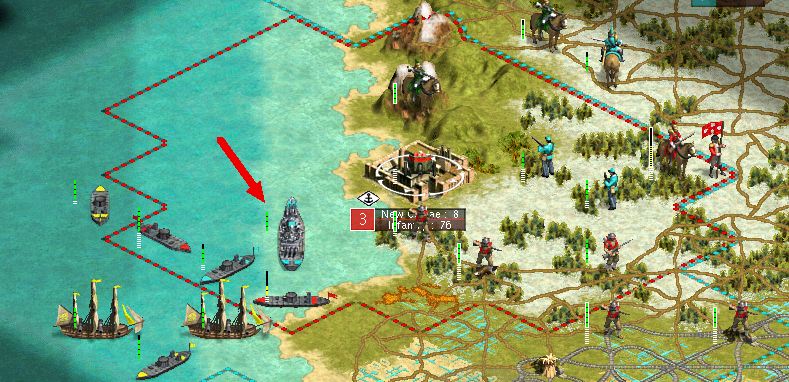
Out of nowhere, a grough of advanced American warships decended on Caesar's galleon fleet, vaporizing a few defending ironclads. With heavy artillery support, ironclads might have been able to fend off a few destroyers, but Lincoln's Battleships would require a new strategy. Roman forces would focus on razing coastal cities to deny Lincoln the facilities to construct or repair his doomsday ships. To conserve irreplacable cavalry, artillery would have to be employed at each city, and the cavalry Armies could be brought in to deal with tough defenders. Many Battleships were sunk in port, and the Naval threat subsided as Southwestern American port cities were destroyed. When America began to use bombers against Cumea out of Northwestern cities, the artillery group had to be diverted to deal with the threat.
Briefly, the waves of bombers put Cumea in danger once again as the destroyed the barracks and damaged the Armies, but the artillery group attacked the Northern cities, destroying the American airforce on the ground. Now the offensive moved on to core American cities where the defenders were well entrenched. Artillery crews reported hitting factories and coal plants in nearly every city (even the smaller ones), and the attacking cavalry suffered many losses destroying Philidelphia with Newton's University and New York with Bach's Cathedral.
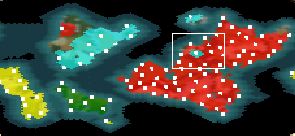
In 1784 AD, American commandos captured a minor Roman city due to the neglegence of Caesar's national guard, leading to the retirement of several top officials (oops!).
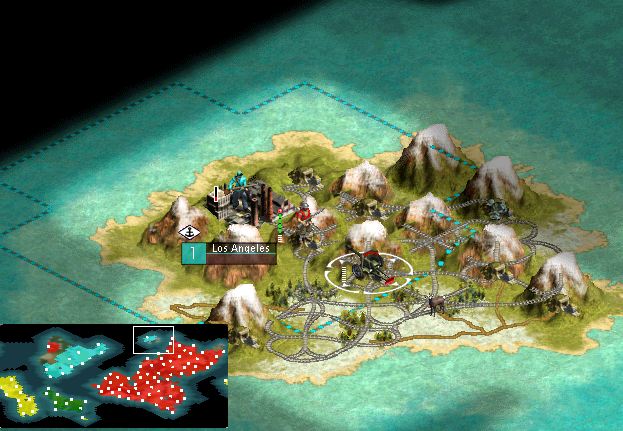
Rome began to catch up technologically due to the development of hospitals, discovering Refining, Scientific Method, Atomic Theory, and Electronics (the latter due to rushed TOE). America had 3 oil reserves, but these were not cut off in time to prevent the construction of more bombers. Aircraft out of the isolated city of Washington bombed the besieging Army as well as infantry guarding key supply roads causing losses to attacking American cavalry. Caesar ordered a small detachment of artillery to pound Washington, but held off on attacking the city to prevent Lincoln from trading for rubber.
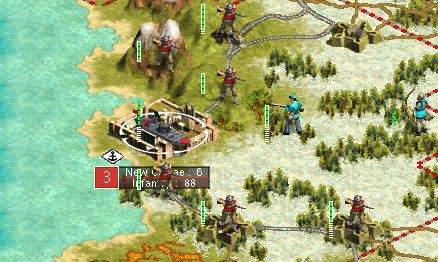
When Chicago was captured along with Admiral Magellan's Naval Command Center, America was down to its last cities. Even as his nation collapsed, Lincoln continued to focus on Cumea using longbowmen with absolutely no hope of success. Seeing the opportunity for expansion, Zululand attempted to construct cities on the island as Roman and American forces were busy attacking one another, and their infantry defenders required significant assets to be diverted from finishing America. Nevertheless, Buffalo with Smith's Trading Post and the remnant of Washinton with Sistene and Copernicus were captured, and Lincoln fled to his last city of New Orleans.
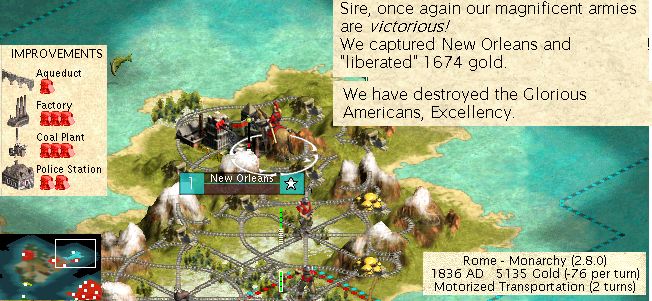
Rome had prevailed against the strongest opponent in the world, but Caesar was unsatisfied that the Japanese and Zulu should remain defiant. On the same year that New Orleans fell, the invasion of Japan began.
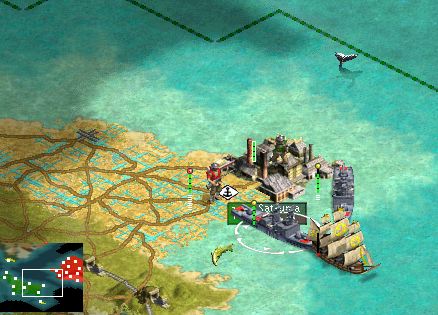
7 loaded galleons with their ironclad escorts brought in a large supply of fresh cavalry, infantry, and artillery at 1730 AD. As American forces continued to focus on Cumea, a sizable group of artillery was brought to bear on Atlanta, causing great damage to the rifleman defenders and allowing cavalry to charge in and destroy the city. However, casualties were high while taking Atlanta, and replacing losses would not be easy now that America had modern ships.

Out of nowhere, a grough of advanced American warships decended on Caesar's galleon fleet, vaporizing a few defending ironclads. With heavy artillery support, ironclads might have been able to fend off a few destroyers, but Lincoln's Battleships would require a new strategy. Roman forces would focus on razing coastal cities to deny Lincoln the facilities to construct or repair his doomsday ships. To conserve irreplacable cavalry, artillery would have to be employed at each city, and the cavalry Armies could be brought in to deal with tough defenders. Many Battleships were sunk in port, and the Naval threat subsided as Southwestern American port cities were destroyed. When America began to use bombers against Cumea out of Northwestern cities, the artillery group had to be diverted to deal with the threat.
Briefly, the waves of bombers put Cumea in danger once again as the destroyed the barracks and damaged the Armies, but the artillery group attacked the Northern cities, destroying the American airforce on the ground. Now the offensive moved on to core American cities where the defenders were well entrenched. Artillery crews reported hitting factories and coal plants in nearly every city (even the smaller ones), and the attacking cavalry suffered many losses destroying Philidelphia with Newton's University and New York with Bach's Cathedral.

In 1784 AD, American commandos captured a minor Roman city due to the neglegence of Caesar's national guard, leading to the retirement of several top officials (oops!).

Rome began to catch up technologically due to the development of hospitals, discovering Refining, Scientific Method, Atomic Theory, and Electronics (the latter due to rushed TOE). America had 3 oil reserves, but these were not cut off in time to prevent the construction of more bombers. Aircraft out of the isolated city of Washington bombed the besieging Army as well as infantry guarding key supply roads causing losses to attacking American cavalry. Caesar ordered a small detachment of artillery to pound Washington, but held off on attacking the city to prevent Lincoln from trading for rubber.

When Chicago was captured along with Admiral Magellan's Naval Command Center, America was down to its last cities. Even as his nation collapsed, Lincoln continued to focus on Cumea using longbowmen with absolutely no hope of success. Seeing the opportunity for expansion, Zululand attempted to construct cities on the island as Roman and American forces were busy attacking one another, and their infantry defenders required significant assets to be diverted from finishing America. Nevertheless, Buffalo with Smith's Trading Post and the remnant of Washinton with Sistene and Copernicus were captured, and Lincoln fled to his last city of New Orleans.

Rome had prevailed against the strongest opponent in the world, but Caesar was unsatisfied that the Japanese and Zulu should remain defiant. On the same year that New Orleans fell, the invasion of Japan began.

Zwingli
Prince
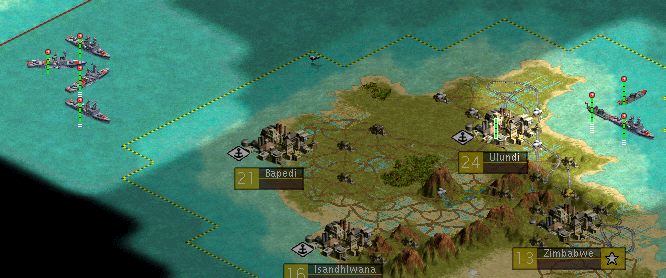
Now that America was out of the picture, Roman destroyers were mass produced, sweeping the oceans clean of inferior Zulu and Japanese ships. The path was now clear for the invasion of Zululand to commence.
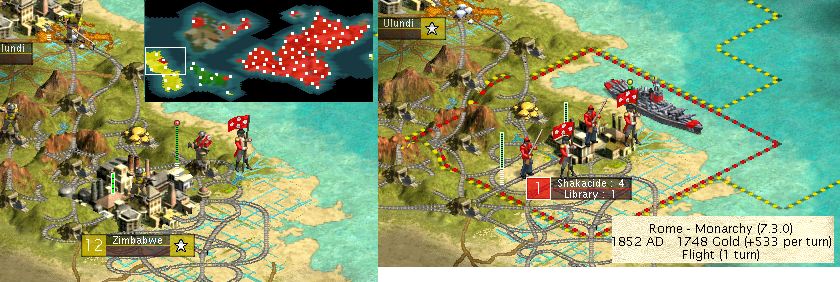
A landing force consisting solely of 7 armies accumulated during the American campaign plus supporting artillery burned Zimbabwe to the ground, constructing "Shakacide" to take its place. The Romans had obtained strong footholds on both Japan and Zululand, and were building a massive mechanized tank force on the main continent. Dozens of Tank divisions were flown in every year, completely overwhelming the relatively strong defenses of Zululand. Artillery, warships, and aircraft were employed to aid in weakening the forces of Shaka and Tokugawa, blasting both cities and key resources in advance of the tank hoards.
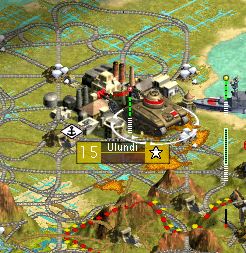
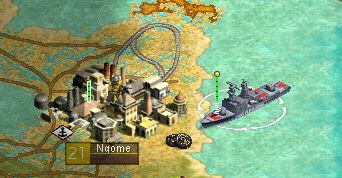
Japan, which had been weakened by repeated pillaging raids over the years, was the first to succumb to the onslaught. Their infantry defending in relatively small cities stood no chance against the unending Roman tanks, and their poor land did not yield enough production to mount a credible counterattack.
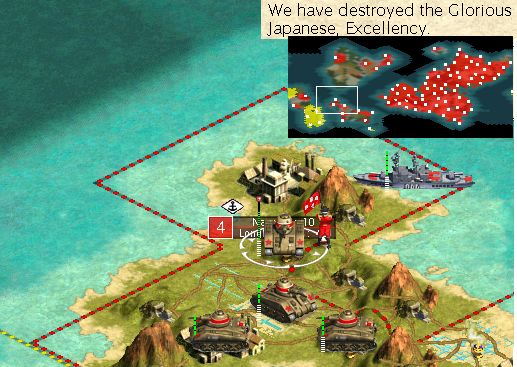
The Zulu were more powerful, defending from strong metropoli and counterattacking with significant numbers of cavalry against the Armies in Shakacide. Caesar was undeterred by this resistance, and ignored massive casualties as he sent tank columns against the huge core Zulu cities. A replacement for every lost tank could be quickly airlifted into Shakacide, allowing the advance to the South to continue unimpeded. In 1880 AD Shaka's last major city of Mpondo fell, leaving Zululand with only two frozen and bombed out towns in the far South.
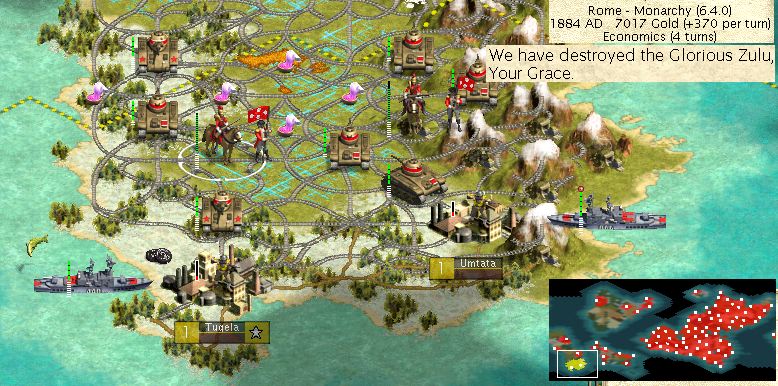
Bismarck, Hamurabi, Mao, Lincoln, Tokugawa, and Shaka were paraded to the Colosseum of Babylon for the entertainment of the Roman public as Caesar received his grand coronation. All resistance against the rule of Caesar had been crushed, so he took up his rightful title as the world's true and only Emperor.
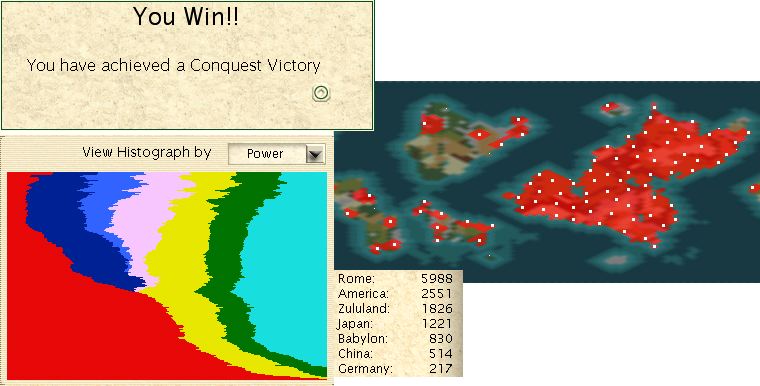
Dirty Harry
Chieftain
Bravo, Zwingli!!!!
A masterful performance!


A masterful performance!


pdescobar
Moo, baby. Moo.
Well done Zwingli! 
That was an awesome performance, and a very enjoyable read. Congradulations on the win and thanks for sharing it with the rest of us.

That was an awesome performance, and a very enjoyable read. Congradulations on the win and thanks for sharing it with the rest of us.

Matthix
Grolsch Lover
impressive victory! 

Gengis Khan
Deity
Simply Amazing!! I didn't think it was possible.
What's next?? 10CC Diety AW??
What's next?? 10CC Diety AW??

Nad
Known Troublemaker
Magnificent!
Surely one of the best Civ3 games played.
Warmest congratulations.
Surely one of the best Civ3 games played.
Warmest congratulations.
Daedalus420
Chieftain
- Joined
- Jun 24, 2003
- Messages
- 29
 Amazing, I am truely amazed
Amazing, I am truely amazed
Bam-Bam
Hammerhead
Or in the Epics! This win makes two known AWD victories, and Urugharakh is returning to the epics. Alas for the rift between PCs and Macs!
Absolutely masterful game, and wonderful story Zwingli.
Absolutely masterful game, and wonderful story Zwingli.
Zwingli
Prince
Thanks for all of the congratulatory commentary  . This was a fun game and an enjoyable story to write, as well as an opportunity to use some of the less appreciated aspects of the game. It is not often that armies, naval warfare, or cannons play such a pivotal role in the outcome of a game, but they can become useful in the unusual environment of an always war.
. This was a fun game and an enjoyable story to write, as well as an opportunity to use some of the less appreciated aspects of the game. It is not often that armies, naval warfare, or cannons play such a pivotal role in the outcome of a game, but they can become useful in the unusual environment of an always war.
Of course, my relative isolation and the early war between the enemy civs in this game allowed me to consolidate a strong position before the onrush of units began. I figure that ultra-agressive Germany probably declared war on Babylon, then used the 110g I gave them for their territory map + Pottery (upon initial contact before declaring war) to buy an alliance with China against Babylon leading to the political situation which existed when I made contact with China and Babylon.
1500 BC (first German city has been destroyed)
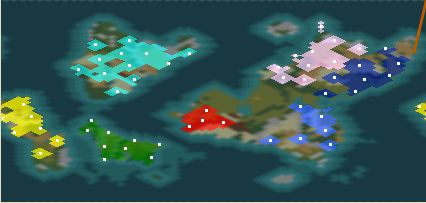
It would be interesting to see if AWD is possible on a standard size Pangea, although it would probably require a defensible chokepoint and a hoard of catapults to be remotely feasable.
--------------------------
As for Mac issue, at least all of those insane tech pace deity games on the obsolete patches were helpful preparation for this type of varient. (1886 AD Conquest? The spaceship should have launched in 1500 AD )
)
 . This was a fun game and an enjoyable story to write, as well as an opportunity to use some of the less appreciated aspects of the game. It is not often that armies, naval warfare, or cannons play such a pivotal role in the outcome of a game, but they can become useful in the unusual environment of an always war.
. This was a fun game and an enjoyable story to write, as well as an opportunity to use some of the less appreciated aspects of the game. It is not often that armies, naval warfare, or cannons play such a pivotal role in the outcome of a game, but they can become useful in the unusual environment of an always war.Of course, my relative isolation and the early war between the enemy civs in this game allowed me to consolidate a strong position before the onrush of units began. I figure that ultra-agressive Germany probably declared war on Babylon, then used the 110g I gave them for their territory map + Pottery (upon initial contact before declaring war) to buy an alliance with China against Babylon leading to the political situation which existed when I made contact with China and Babylon.
1500 BC (first German city has been destroyed)

It would be interesting to see if AWD is possible on a standard size Pangea, although it would probably require a defensible chokepoint and a hoard of catapults to be remotely feasable.
--------------------------
As for Mac issue, at least all of those insane tech pace deity games on the obsolete patches were helpful preparation for this type of varient. (1886 AD Conquest? The spaceship should have launched in 1500 AD
 )
)Txurce
Deity
Zwingli, this is what Civ should be about. Congratulations! You couldn't have done a better job of detailing how combined arms made all the difference. It never would have occurred to me that you would need three armies plus to barely hang onto a city on a hill. But your tactical masterpiece has to be the permanent isolation of Washington. I hope I never forget that, if I ever find myself in a situation as interesting as yours.
Similar threads
- Replies
- 0
- Views
- 745
- Replies
- 3
- Views
- 599

